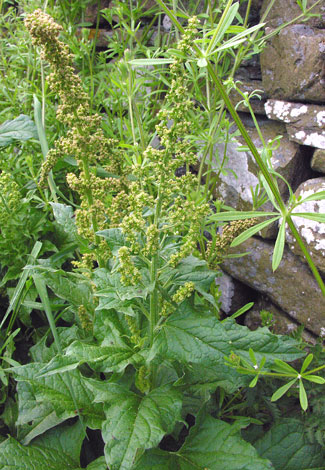Chenopodium bonus-henricus Good King Henry C DD N

This was a plant grown as a vegetable and even 40 years ago in some East Anglian towns Chenopodium bonus-henricus was eaten instead of the stronger flavoured spinach. A plant which was grown a for eating ought really to be more wide spread than it seem to me to be. I see it only rarely and this site is one of the famous ones as it has been here for many years.
According to Geoffrey Grigson in The Englishman's Flora the name comes from the Tudor herbalists and has little if anything to do with any of our King Henrys.
The Germans called it Guter Heinrich (Good Henry) and it was described as being similar to Mercurialis annua (which it isn't very in my opinion) but Mercurialis annua, a medicinal herb, needed to be distinguished from the common and poisonous Mercurialis perennis which was called Böser Heinrich (Bad Henry). So it was called Good Henry because you could eat C. bonus-henricus and Bad Henry because you'd be poisoned by Mercurialis perennis.
Heinrich in German herbalist names is thought to have a similar use as Robin in English plant names - i.e. the name of an elf. We British have put the "King" bit into the name making it sound as though it had something to do with the Kings of England which it doesn't.
C. bonus-henricus is common throughout England and Wales and is found in eastern Scotland. It is less common in Ireland but there are records from most parts of the island.



